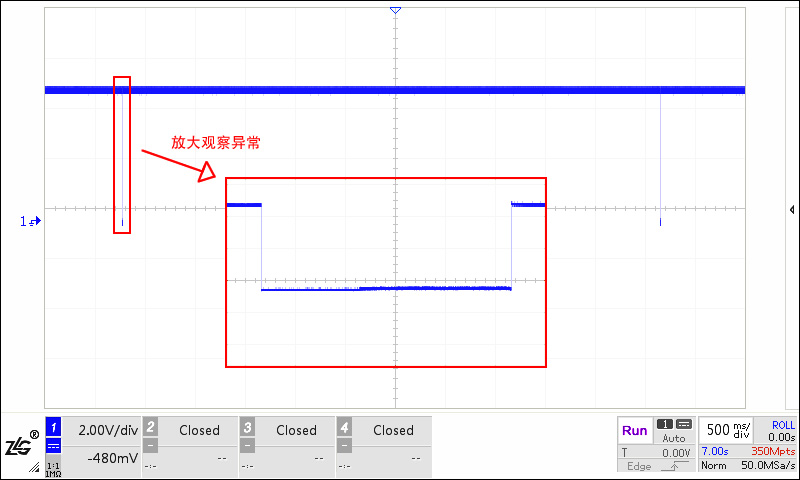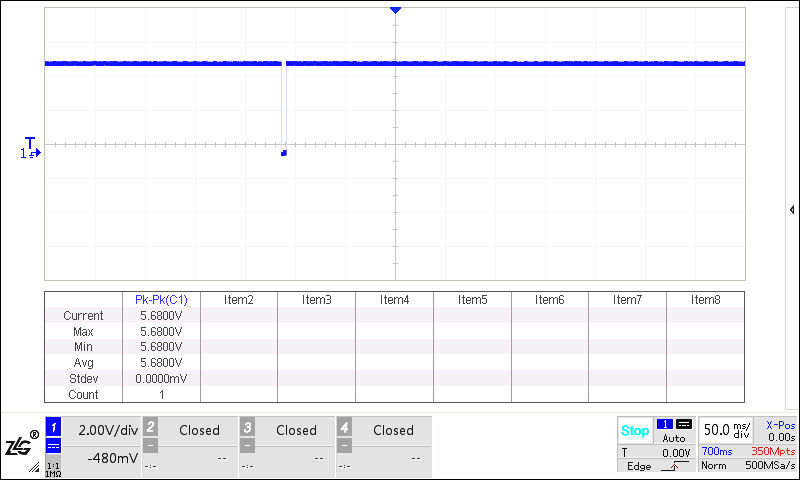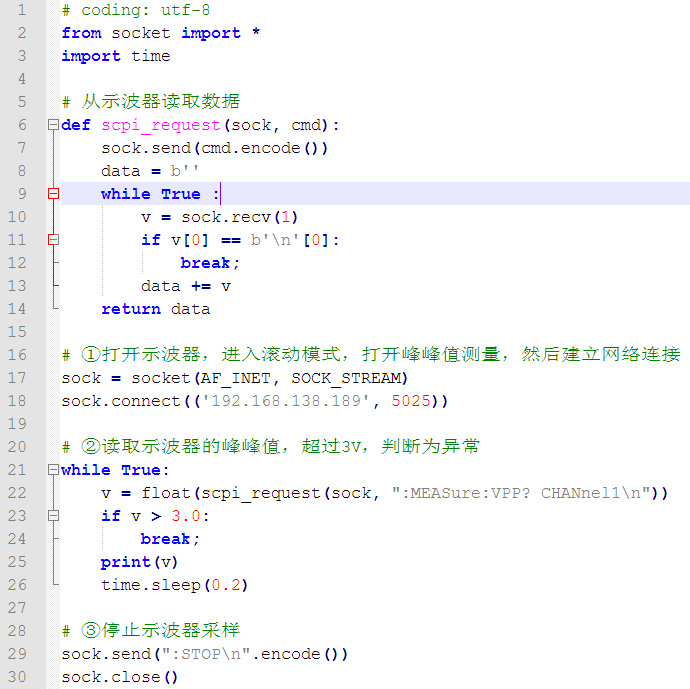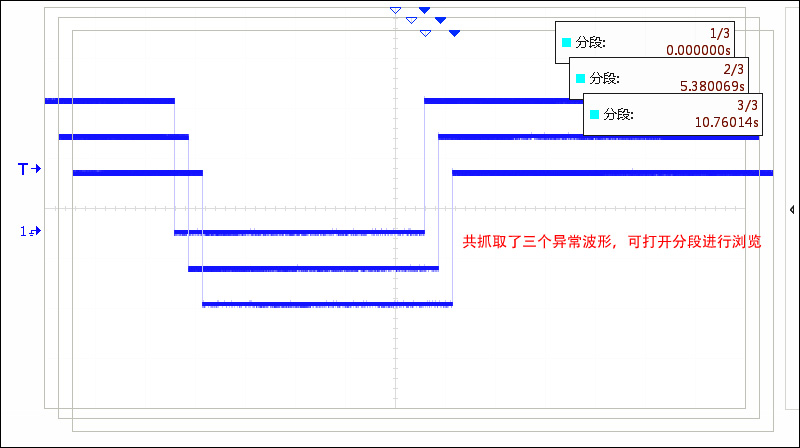1. Scrolling Mode
You may seldom use the rolling mode, but it is the simplest and most crude way to analyze problems. All you have to do is determine how long the anomaly will take to appear and whether the sampling rate is sufficient. For example, if the anomaly appears within 5 seconds, set the rolling mode to collect data for 7 seconds and then stop. Under the premise of sufficient sampling rate, I believe the problem will be solved by you.

Figure 1 Rolling acquisition of voltage drop waveform
Summary: The rolling mode has "no dead zone" and any abnormal problem can be captured, but the premise is that the sampling rate must be high enough. As shown in the figure above, the sampling rate is 50MHz. When the abnormal frequency exceeds 25MHz, it is difficult to collect accurate waveforms. The rolling mode of ZDS4000 supports a maximum sampling rate of 500MHz, and the longest data collection time is 7.2 hours (the sampling rate is 20KHz at this time).
2. Rolling mode + online monitoring
Everything has its pros and cons, and the scrolling mode certainly has its disadvantages. Its disadvantages are: it does not support triggering and automatic stopping after triggering. That is, when using scrolling to analyze problems, you need to use your eyes to determine abnormalities, and after catching the abnormality, manually stop sampling, which is sometimes very difficult. Here is a method for online monitoring of abnormalities. First, turn on the scrolling measurement function of ZDS4000, then read the measured value through the network, determine whether there is an abnormality, and finally stop the oscilloscope sampling. Taking the voltage drop as an example (the peak-to-peak value is 5V when the problem occurs), the oscilloscope settings and python monitoring script are as follows:

Figure 250ms rolling mode, peak-to-peak measurement, 500MHz sampling rate

Figure 3 Python online monitoring source code
Summary: The use of online monitoring methods can make up for the shortcomings of scrolling to a large extent, but it is not a panacea. If the measurement function provided by the oscilloscope cannot detect the error, it will be very difficult to deal with. Fortunately, ZDS4000 provides more than 50 measurements, and most of the errors can be detected.
3. Trigger + Segmented Storage
Triggering is one of the most commonly used functions of an oscilloscope. The specific settings are relatively complicated. You can follow the following ideas to operate:
1. Which channel should be used for triggering? Set the trigger source.
2. What does the anomaly look like? Set the trigger type and trigger level.
3. Is the anomaly fleeting? Turn on the template trigger and move the template to the area where the abnormal waveform is located.
4. How to stop automatically after catching an exception? Click Single to run, and it will stop automatically after catching an exception.
5. How to collect exceptions multiple times? Set the Normal trigger, click RUN, stop manually after multiple collections, turn on segmented storage (Seg), and browse all captured exceptions.

Figure 4 Segmented browsing of abnormal waveform
Summary: In non-rolling mode, there is a dead zone in sampling. Abnormalities in the dead zone cannot be caught and will not be displayed on the screen. The dead zone time can be confirmed by the refresh rate indicator of the oscilloscope. The higher the refresh rate, the smaller the dead zone time, and the higher the accuracy of catching abnormalities.
Summarize:
Even if the problem is strange, as long as you find it correctly, you are not far from solving it! ZDS4000 series oscilloscope has the advantages of 512M deep storage, high refresh rate, and true parameter measurement. It covers all the functions of the above three methods and can help you improve the efficiency of problem solving.
Previous article:Securing your train communications - MVB
Next article:How to test active crystal oscillator signal?
- Popular Resources
- Popular amplifiers
- From probes to power supplies, Tektronix is leading the way in comprehensive innovation in power electronics testing
- Seizing the Opportunities in the Chinese Application Market: NI's Challenges and Answers
- Tektronix Launches Breakthrough Power Measurement Tools to Accelerate Innovation as Global Electrification Accelerates
- Not all oscilloscopes are created equal: Why ADCs and low noise floor matter
- Enable TekHSI high-speed interface function to accelerate the remote transmission of waveform data
- How to measure the quality of soft start thyristor
- How to use a multimeter to judge whether a soft starter is good or bad
- What are the advantages and disadvantages of non-contact temperature sensors?
- In what situations are non-contact temperature sensors widely used?
- LED chemical incompatibility test to see which chemicals LEDs can be used with
- Application of ARM9 hardware coprocessor on WinCE embedded motherboard
- What are the key points for selecting rotor flowmeter?
- LM317 high power charger circuit
- A brief analysis of Embest's application and development of embedded medical devices
- Single-phase RC protection circuit
- stm32 PVD programmable voltage monitor
- Introduction and measurement of edge trigger and level trigger of 51 single chip microcomputer
- Improved design of Linux system software shell protection technology
- What to do if the ABB robot protection device stops
- Learn ARM development(21)
- Learn ARM development(20)
- Learn ARM development(19)
- Learn ARM development(14)
- Learn ARM development(15)
- Analysis of the application of several common contact parts in high-voltage connectors of new energy vehicles
- Wiring harness durability test and contact voltage drop test method
- From probes to power supplies, Tektronix is leading the way in comprehensive innovation in power electronics testing
- From probes to power supplies, Tektronix is leading the way in comprehensive innovation in power electronics testing
- Sn-doped CuO nanostructure-based ethanol gas sensor for real-time drunk driving detection in vehicles
- TMS320C6678 memory access performance
- About Voltage Follower
- Advantages of combining TI analog devices with DSP
- SiC market is growing rapidly
- 【Chuanglong TL570x-EVM】Evaluation 07 - QT Date Interface Development
- Purgatory Legend-Battle of Doubler Circuits
- 29 "Wanli" Raspberry Pi car - straight-driving deviation problem and new control mode
- Bluetooth remote control serial port problem
- How to test the performance parameters of op amps, such as bandwidth, noise and slew rate?
- Application of Dacai UART screen in air detector

 TLC27L2ACPP1
TLC27L2ACPP1













 京公网安备 11010802033920号
京公网安备 11010802033920号